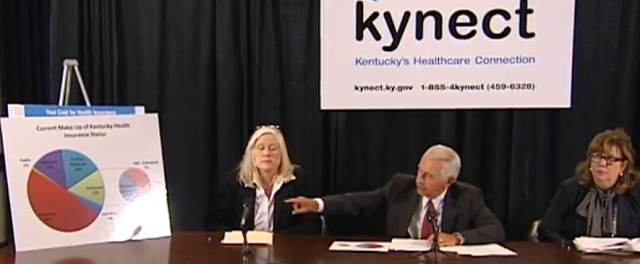Beshear announces rates in health-insurance exchange, says Kentuckians will like them, especially the federal ‘discounts’

Kentucky Health News
Tossing out the first examples of what Kentuckians will pay for required health coverage through the state health insurance exchange that opens Oct. 1, Gov. Steve Beshear predicted yesterday, “The vast majority of people are going to be very excited about what they find. . . . When they check it out, they’re gonna sign up.”
Beshear said there has been much speculation about premiums, but little talk about the federal subsidies (he called them “discounts”) that the exchange will offer to individuals and households with incomes up to 400 percent of the federal poverty level. He said subsidies will be available to individuals earning as much as $45,960 a year, and to families of four with income as high as $94,200 a year.
 |
| Beshear notes that 15 percent of Kentuckians are uninsured (light green in pie chart); at left is Kynect Director Carrie Banahan; at right is Health and Family Services Secretary Audrey Haynes. |
Tea Party activist David Adams, who recently lost the first round of his court battle to stop the exchange and Medicaid expansion, has said some consumers will have to pay almost double for their current coverage, and he told The Courier-Journal that the subsidies won’t make up for that.
About 15 percent of Kentuckians, more than 640,000, have no health coverage. About 308,000 will become eligible for the Medicaid program, which is being expanded under federal health reform to include people with incomes up to 138 percent of the poverty level. Among the other 332,000, 85 percent of those people will qualify for subsidies, Beshear said, and in some cases the subsidy will be 100 percent.
The subsidies are available only through the insurance exchange, which the state has branded Kynect. The exchange will offer five plans, with premiums based only on age, income, geography, number of people on the plan and how many of them use tobacco.
 |
| State’s example of bronze plan for a smoker earning $30,000 |
The ceiling for the tobacco surcharge is 40 percent, which has drawn criticism, but the state Department of Insurance said that is the most common surcharge in the state’s health-insurance industry. Beshear said a 50-year-old man who smokes and earns $30,000 a year would still pay only $160 a month for coverage under the “bronze” plan, the one with the lowest premiums and highest deductibles and other out-of-pocket costs. Under the plan with the lowest deductibles, he would pay $279.
The bronze plan has a very large $6,300 deductible. The other standard plans are silver, gold and platinum; their deductibles are 20 percent (called “co-insurance”) plus $4,600, $2,500 and $1,000, respectively. The exchange will also offer people under 30 a plan that provides only catastrophic coverage with a “very high deductible” and no subsidy, Beshear said.
Among other examples in the bronze plan, which has a $6,300 annual deductible: A nonsmoking farmer in his mid-50s earning $34,000 a year would pay $47; a family of four with no smokers and $70,000 annual income would pay $403; a 32-year-old single mother with two children and $40,000 income would pay $133.
Beshear offered no average cost, saying “There are too many factors to create an average that would be useful. . .. The bottom line is that families must do some research,” which the Kynect website and call center can help them with starting Oct. 1. He said the plans shouldn’t be compared to individual plans offered in commercial market, because “the coverages are so much different.”
One big difference is that under the federal health reform law, all plans must cover prescription drugs, hospital care, maternity and newborn services, mental health and substance abuse services, emergency care, rehabilitative services and devices, laboratory services, preventive and wellness services, chronic disease management and pediatric services. Also, they are not allowed to have any dollar limits on coverage.
The law also bans insurance companies from denying or dropping coverage because of someone’s health condition, meaning that “For the first time we’re gonna be able to provide affordable
health insurance of every single Kentuckian. . . . This is a historic event in the commonwealth.” The federal law requires practically every American to have health insurance.
The plans’ geography is based on the state’s eight Medicaid regions. Beshear said at least two insurance companies will be offering plans in each region, unlike some states. He said four companies have proposed to offer dental insurance, but those plans are still under review by Kynect and the Department of Insurance, which evaluates them for actuarial soundness.
Humana Inc., Anthem Blue Cross and the new Kentucky Health Cooperative will offer policies for individuals, while Anthem, the co-op, Bluegrass Family Health and United Healthcare will provide employee coverage for businesses. Employers with fewer than 50 workers are not required to insure them, and those with fewer than 25 employees can get tax credits for doing so.
The rates are for 2014. Beshear
said companies were “understandably cautious” in setting premiums without any experience on which to base them, so he expects rates to decrease in 2015.
Kentucky Health News is an independent news service of the Institute for Rural Journalism and Community Issues, based in the School of Journalism and Telecommunications at the University of Kentucky, with support from the Foundation for a Healthy Kentucky.